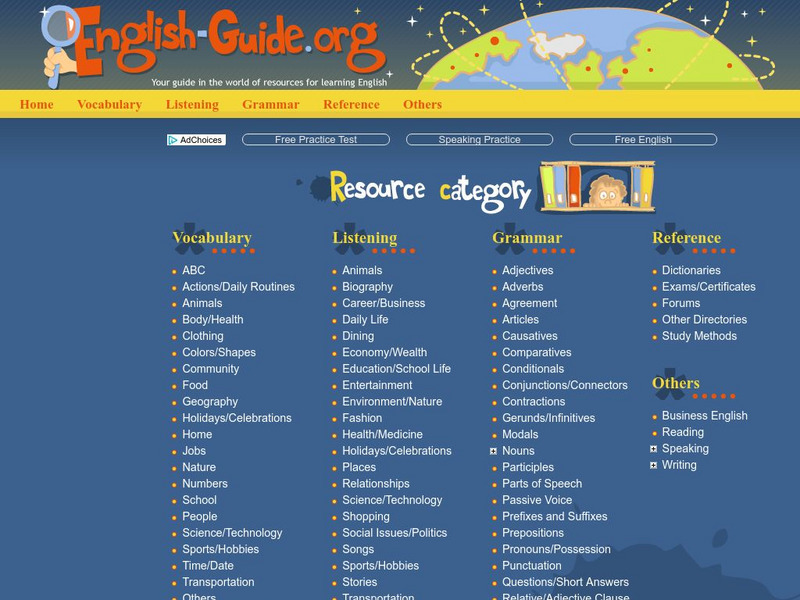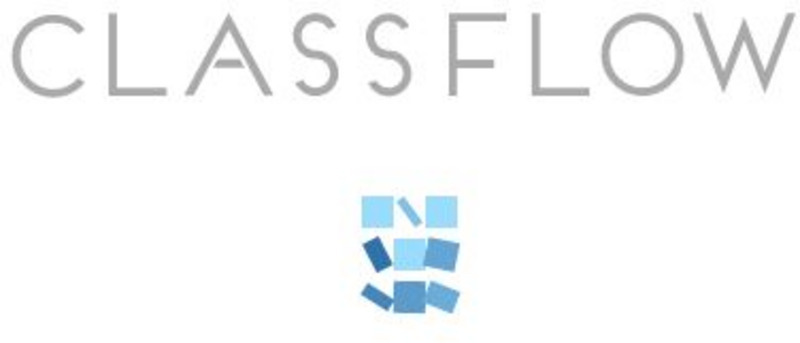Hi, what do you want to do?
Other
English Guide
Homepage with links to resources and activities to help support English language learners. Links are organized into vocabulary, listening, grammar and other categories. Some activities are theme-based, focusing on animals, color/shapes,...
Other
Kim's Korner: Color Coded Parts of Speech Kinesthetic Lesson Plan
Students can brush up on their knowledge of the parts of speech when they do this lesson. This site contains a kinesthetic lesson plan that caters to children with all types of learning styles.
PBS
Pbs Learning Media: How to Punctuate Items in a Series
Another way to confuse readers or audiences is not using commas and conjunctions when listing items in a series. Always use a comma in between items in a series, and use a conjunction before adding the last item in a list. [0:44]
PBS
Pbs Learning Media: How to Use Commas With Conjunctions
Conjunctions can join two separate clauses, but sometimes they need commas. Learn how to do so correctly with this video. [0:48]
PBS
Pbs Learning Media: How to Use Conjunctions
Conjunctions are a part of a speech that connects different parts of a sentence, such as groups of words, clauses, or phrases. [0:41]
PBS
Pbs Learning Media: Using Reference Materials to Correctly Spell Words
Some words may sound like other words, but using the wrong word can lead to confusion and madness. A dictionary would be helpful to make sure you know what you're talking about! [0:40]
PBS
Pbs Learning Media: How to Use the Correct Capitalization
Capitalizing is extremely important. Not only is it proper writing, but it also makes writing look polished and finished. Learn what should be capitalized and what shouldn't! [0:53]
PBS
Pbs Learning Media: How to Use Different Word Functions
Remember that each type of word has a special job or function to be used in a sentence. Subjects, verbs, and objects all have different uses. Remember to use them correctly! [0:33]
PBS
Pbs Learning Media: Using Commas and Quotations
Quotations and commas are two very useful punctuation tools that indicate dialogue and brief pausing in sentences. Learn how to use them correctly! [0:46]
PBS
Pbs Learning Media: How to Introduce Lists and Quotes With Colons
Colons are punctuation marks that can signal a quotation. However, to use colons correctly, whatever comes before the colon must be a complete sentence. Know when and how to use colons! [0:45]
PBS
Pbs Learning Media: How to Recognize a Phrase
A phrase is a group of related words that does not include both a subject and a verb. It only has one or the other! [0:39]
PBS
Pbs Learning Media: Sentence Fragments
Sentence fragments can't stand alone, because they do not express a complete thought. Run-ons put two complete sentences together in one sentence without separating them. [0:35]
PBS
Pbs Learning Media: How to Use Prepositions
Prepositions indicate locations, whether physical or in time. Around, in, outside, before, during. Prepositions help us know the when and where! [0:48]
PBS
Pbs Learning Media: Forming and Using Possessive Nouns
Possessives show when a noun belongs to someone. It is often indicated with an apostrophe "s", but when words end in "s" only an apostrophe is added.
PBS
Pbs Learning Media: How to Use Reference Materials
A dictionary is one of the most useful reference books anybody could ever use. Learn how to properly understand a dictionary's formatting and content! [0:46]
PBS
Pbs Learning Media: Some Frequently Confused Words
Some words in English can look and sound similar, but have entirely different meanings. Keep an eye and ear out for them; beware of commonly confused words. [0:40]
Love To Know Media
Your Dictionary: Charades Word Lists for Kids
This is a list of words to use for charades for kids including book titles, children's movies, names of famous people, and geographical locations. The books and movie titles are broken down by age groups.
Other
K12 Reader: Reading Instruction Resources: Collective Noun Worksheets
This learning resource provides five downloadable worksheets that reinforce the topic of "collective nouns."
PBS
Pbs Learning Media: How to Link Clauses With Semicolon
Semicolons join two closely related independent clauses in a single sentence. Without these, there would be run-on sentences that no one could slow down! [0:57]
PBS
Pbs Learning Media: Using Punctuation for Breaks and Pauses
Punctuation indicates how one should read any sentence. Commas, for example, indicate when a reader should take a brief pause, either for emphasis or for comprehension. [0:40]
PBS
Pbs Learning Media: What Are Collective Nouns?
A collective noun is a word that refers to a group, such as a collection, a herd, a team! [0:37]
ClassFlow
Class Flow: Grammar Adjectives
[Free Registration/Login Required] This flipchart identifies adjectives in shared reading and discusses what they have in common. Students will experiment with deleting and substituting adjectives and noting effects on meaning. They'll...
ArtsNow
Arts Now Learning: My Sound Is the Best! [Pdf]
In this lesson, students will use music as an impetus for stating and supporting opinions. They will compose an opinion poster based on a narrative about a train using percussion instruments. This will involve group work which can lead...
US Department of Education
U.s. Dept. Of Education: Compact for Reading: Kindergarten Activities (Spanish)
Links to 100 kindergarten activities arranged by skill set and designed to improve reading and writing. All activities are in PDF format and are ready to print and use. They can be downloaded individually, according to skill set, or as...
Other popular searches
- English Grammar
- Grammar Worksheets
- Spanish Grammar Worksheets
- Grammar Worksheets Pronouns
- Grammar Exercise
- Esl Lessons Grammar
- Grammar Games
- French Grammar Worksheets
- Future Tense English Grammar
- 1st Grade Grammar
- Esl Grammar Simple Past
- 7th Grade Grammar Worksheets









